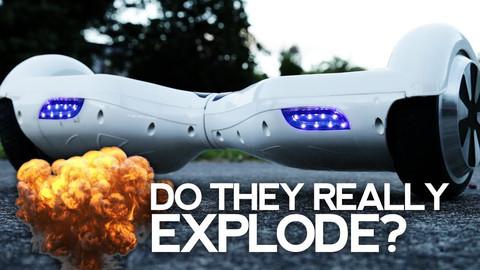There is a lot of misinformation on the internet regarding hoverboard safety, and a lot of speculation has been circulating around the social hierarchy regarding these products, so we just want to clear a few things up based on our own experience with these boards and what we find to be true regarding their manufacturing quality and overall safety. There are 2 main reasons why hoverboards are catching fire and exploding, as follows:
Problem #1 - Over Charging

The number 1 safety hazard to any hoverboard, or lithium ion battery at that, is over-charging. Running too much electrical current through a delicately constructed lithium ion energy cell is bad news, and can cause problems. So that is the number 1 golden rule, don't leave it charging overnight and some might even be as strict as to not be out of site while it's plugged in and charging at home. Now some manufacturers have even gone so far as to offer protective charging cases along with these boards, in order to prevent house fires due to over-charging them inside. I say, simply don't over-charge them at all. 1 - 2 hours is plenty of time. Charge it for a bit, ride it for a bit...how hard is that? Simple right? Do it! Implement it.
Problem #2 - Cheap Batteries

All of the boards coming out of China are virtually the same model, the only difference are the batteries. And there are 2 different types of batteries: the good batteries and the bad batteries. The good batteries are inspected, approved, and certified for use with motorized scooters and will have a stamp on them with either an inspection number such as iso9001 like this battery here:

Notice that is also has the brand name "Samsung" written directly on the battery. Now we can probably judge from these industry known trademarks that this battery is safe, and rated for use with motorized scooters.
And the second type of battery that is coming directly out of China that is safe to use in motorized scooters will have CE and ROHS certification stamps on it, as this is the overseas group equivalent of the UL approval in the United States. Some people think this type of battery is not good because it doesn't have UL approval, not knowing that there is a completely different approval system for batteries that are manufactured overseas.

So those two examples we just went over above are safe, as these batteries have been tested, inspected, and rated for use with electric motorized scooters. That doesn't mean, however, that you can over-charge them, and abuse them and they will continue to operate efficiently. Even if you own a board with one of these batteries you still shouldn't leave it on the charger for more than 2 hours, and you shouldn't overwork the battery, such as continuing to ride it when the board is beeping and the battery has been sufficiently drained. Follow these key tips and you will be a happy hoverboarder! Fail to heed these guidelines and you may end up one of the unlucky few that has a hoverboard problem.
These are the batteries to watch out for, unmarked, uninspected, unstamped batteries:

But also be careful because the stamps and certifications can be faked, so make sure you are dealing with a reputable supplier, dealer, or distributor that is up front about what they are selling, and not some guy off of Craigslist, eBay, or Amazon, attempting to sell some cheap board for £100 is almost 100% going to be a scam. Be smart people, if it costs under £200 it's most definitely a piece of garbage. The quality, inspected batteries themselves cost £100 each, so just think if the board you are buying is only £100 then the parts that have gone into making it are definitely not quality, inspected, and rated for motorized use, because if they were then the board would cost more. You get what you pay for, and we can say with 100% honestly and certainty that ALL BOARDS ON OUR SITE ARE CERTIFIED, INSPECTED, APPROVED, AND RATED FOR MOTORIZED ELECTRIC SCOOTER USE!







